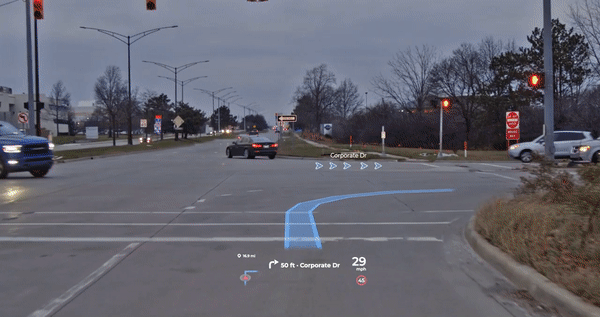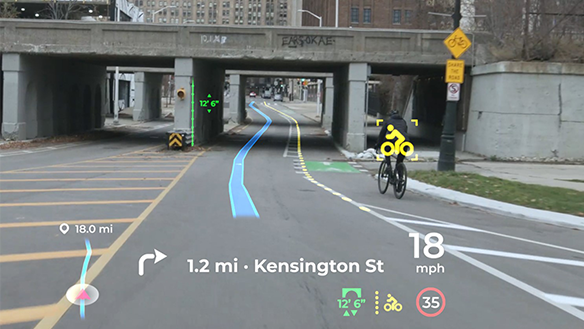Eye-tracking, AI navigation, and 3D imaging radar promise next-level road traffic safety.
Japanese electronics manufacturer Panasonic took CES by storm this year, revealing new changes to its mysterious UHD VR glasses as well as a new augmented reality heads-up display designed specifically for automotive vehicles.
Revealed earlier this week during the all-digital showcase, this futuristic heads-up display uses a combination of AR visuals and AI technology from the companies SPYDR cockpit domain controller to deliver crucial information in real-time without distracting the driver. Features include advanced collision detection, AI-powered route guidance, eye-tracking, near-field and far-field content for basic vehicle information (like speed), and a variety of other useful functions designed to keep you aware of what’s happening on the road.
According to Panasonic, the AR HUB was built using a proprietary development process referred to as PRIZM (Precise placement, Reflection, Intuitive, Zonal, Mission Control) in order to address a variety of driver needs. Here’s a quick breakdown of the key features, as provided by Panasonic:
- Advanced optics – Advanced optical design techniques provide expanded field-of-view (beyond 10 x 4 degrees) for virtual image distance of 10m or greater; detects pedestrians and objects through enhanced low light and nighttime view; tilted virtual image planes adjust visibility of objects in the driver’s field of view; embedded camera system allows discrete monitoring for the driver’s eye location.
- AI navigation accuracy – AI-driven AR navigation technology detects and provides multi-color 3D navigation graphics that adjust with moving vehicle’s surroundings, displaying information like lane markers and GPS arrows where turns will occur and sudden changes such as collisions or cyclists in one’s path
- Vibration control – Panasonic’s proprietary camera image stability algorithm enables AR icons to lock onto the driving environment regardless of the bumpiness of the road
- Real-time situational awareness – Driving environment updates occur in real-time; ADAS, AI, AR environment information updates in less than 300 milliseconds
- 3D imaging radar – Sensor-captured full 180-degree forward vision up to 90 meters and across approximately three traffic lanes
- Compact size – Efficient compact packaging to fit any vehicle configuration
- 4K resolution – Crisp, bright 4K resolution using advanced laser and holography technology, with static near-field cluster information and far-field image plane for AR graphic overlay.

“Panasonic’s AR HUD solutions cover more of the roadway, with traditional cluster content like speed and fuel in the near field as well as 3D overlays in the far field, showing navigation and other critical driver data mapping spatially to the road ahead. And in a future with more self-driving vehicles, our AR HUD could provide an important added level of comfort and assurance for AV passengers as well,” said Scott Kirchner, President at Panasonic Automotive and Executive Director, Panasonic Smart Mobility, in an official release.
The company states its AR HUD was developed in collaboration with hologram technology expert Envisics alongside Phiar, a company specializing in AI-driven automotive computation.
For more information on Panasonic’s AR-enabled HUD visit here.
Image Credit: Panasonic
The post Panasonic’s AR HUD Could Be The Future Of Automotive Safety appeared first on VRScout.




